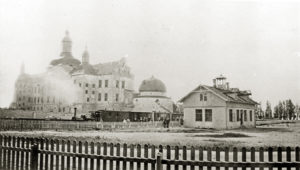The last bit of Östergötland’s narrow gauge
The Wadstena-Fogelsta railway was opened to traffic in 1874. The 9.6 km (6 mile) long line was paid for by the town of Vadstena. The purpose was to connect with the outside world via the Mjölby-Hallsberg line. To keep costs down, the track was built narrow-gauge. The gauge is 891 mm, which is the same as 3 Swedish feet and also the most common narrow-gauge in Sweden. The width of a normal-track railway is otherwise 1435 mm (4ft 8½in) .
A new line between Vadstena and Ödeshög opened in 1888, and the two railways were merged into the newly formed company Fogelsta-Wadstena-Ödeshögs Railway (FWÖJ).

In 1897 the Mellersta Östergötlands Järnväg (Mid-Östergötlands Railway – MÖJ) opened between Linköping and Fågelsta. This line was also built to 891mm gauge and was connected to the FWÖJ. In 1919 the two companies merged, keeping the name MÖJ. In the meantime the Mellersta Östergötlands Järnväg had built a narrow gauge network that stretched from Motala in the west past Linköping to Ringstorp in the East. At Ringstop the line connected to other narrow gauge lines in Östergötland, Småland and Närke.
The MÖJ was a pioneer in the field of electric power and had electrified the stretch to Vadstena. The first electric train between Linköping and Vadstena ran on Christmas Eve 1921. The MÖJ had its heyday during the Second World War, when the trains could run without restrictions thanks to electric power. In 1950 the MÖJ was nationalized. At this time road traffic expanded sharply. Instead of developing the narrow gauge railways, electric power was scrapped in 1956 and replaced by diesel vehicles. The competition from road traffic became increasingly challenging and by 1963 the narrow-gauge saga was all but finished, with the exception of the Vadstena-Fågelsta section. Freight traffic continued here until June 1, 1978.
In 1974, four years before the final closure, the Wadstena Fogelsta Railway Museum Association was formed. The purpose of the association was to preserve the line for the future. Vadstena municipality helped to realise the project of buying land and buildings and the association leases the track from the municipality. The first museum train to Fågelsta ran in 1988.
